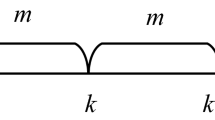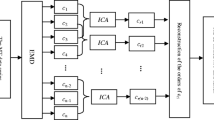Abstract
Time—frequency electromagnetic data contain frequency and transient electromagnetic information and can be used to determine the apparent resistivity both in the frequency and time domains. The observation data contains three types of noise: the harmonics interference at 50 Hz, high-frequency random noise, and low-frequency noise. We use frequency-domain bandstop filtering to remove the harmonics interference noise, segmentation and extension median filtering, and fitting of fixed extremes in empirical mode decomposition to remove the high-frequency and low-frequency noise, respectively; furthermore, we base the selection of median filtering window size on the variance and skewness coefficient of the data. We first remove the harmonics interference at 50 Hz, then the high-frequency noise, and finally the low-frequency noise. We test the proposed methodology by using theory and experiments, and we find that the three types of noises are removed, the phase and amplitude information of the signal are maintained, and high-quality waveforms are obtained in the time domain.
Similar content being viewed by others
References
An, H. B., and Shen, Y. Y., 2005, A method to suppress narrow-band interference based on frequeney domain filter: Optoelectronic Technology & Information, 18(5), 64–68.
Andrew, K. H., 1995, Application of frequency-domain polyphase filtering to quadrature sampling: Proc Spie, 2563, 450–457.
Bai, F. F., Miao, C. Y., Zhang, C., and Gan, J. M., 2010, Studying on denoising algorithm of heart sound signal based on the generalized mathematical morphology:IEEE International Conference on Signal Processing,1797–1800.
Bhusana, P., Jumlong, V., and Christofer, T., 2013, Noise reduction for nonlinear nonstationary time series data using averaging intrinsic mode function: Algorithms, 6, 407–429.
Brian, H. T., and Eric, L. M., 2012, Nonlocal means denoising of ECG signals: IEEE Transactions on Biomedical Engineering, 59(9), 2383–2386.
Chang, K. M., 2010, Arrhythmia ECG noise reduction by ensemble empirical mode decomposition: Sensors, 10, 6063–6080.
Cui, Z. H., Cheng, M. H., Wu, Q. L., and Wang, B. Z., 2005, A technique of fast median filtering and its application to data quality control of doppler radar: Plateau Meteorology, 24(5), 727–733.
Ding, K. L., Sheng, Y. Z., Ou, J. K., 2010, Methods of line-fitting based on total least-squares: Journal of Liaoning Technical University (Natural Science), 29(1), 44–47.
George, T., and Thomas, D. X., 2011, Signal denoising using empirical mode decomposition and higher order statistics: International Journal of Signal Processing, Image Processing and Pattern Recognition, 4(2), 91–106.
Gruber, P., Theis, F., Tomé, A., et al, 2004, Automatic denoising using local independent component analysis: Proceedings Ofs.
He, Z. X., Wang, X. B., Kong, F. S., et.al., 2002, The Time-Frequency electromagnatic sounding method: The annual China geophysical society, Chinese Geophysical Society 18th Annual Conference Proceedings.
He, Z. X., 2006, TFEM method (Patent No.ZL03150098.6.2003).
Huang, N. E., Shen, Z., Long, S. R., et al, 1998, The empirical mode decomposition and the Hilbert spectrum for non-stationary time series analysis: Proceeding: Mathematical, Physical and Engineering Sciences. London: The Royal Society Press, 454(1971), 903–995.
Kai, S., and Monika D., 2012, Audio denoising by generalized time-frequency thresholding: AES 45TH International Conference, Helsinki, Finland, 1–10.
Kalavathy, S., and Suresh, R.M., 2011, A switching weighted adaptive median filter for impulse noise removal: International Journal of Computer Applications, 28(9), 8–13.
Li, C. W., Zhan, L. W., and Shen, L. Q., 2015, Friction signal denoising using complete ensemble EMD with adaptive noise and mutual information: Entropy, 17, 5965–5979.
Li, G., Xiao, X., Tang, J. T., et al, 2017, Near-source noise suppression of AMT by compressive sensing and mathematical morphology filtering: Applied Geophysics, 14(4), 581–590.
Li, H. Q., Wang, X. F., and Chen, L., et al., 2014, Denoising and R-peak detection of electrocardiogram signal based on EMD and improved approximate envelope: Circuits Syst Signal Process, 33, 1261–1276.
Li, H., Sun, Y. L., and Xu, B. C., 2007, Noise elimination of PD signals by independent component analysis: Advanced Engineering Sciences, 39(6), 143–148.
Liu, W., Cao, S. Y., Chen, Y. K., Zu, S. H.,2016,An effective approach to attenuate random noise based on compressive sensing and curvelet transform: Journal of Geophysics and Engineering, 13, 135–145.
Macnae, J., Lamontagne, Y., and West, G.,1984, Noise processing techniques for time-domain EM systems: Geophysics, 49(7),934–948.
Mathieu, R., Olivier, J., Christophe, M., and Frederic, B., 2006, Mitigating pulsed interference using frequency domain adaptive filtering: Ion Gnss International Technical Meeting of the Satellite Division of the Institute of Navigation, 2251–2260.
Mo, D., Jiang, Q. Y., Li, D. Q., et al, 2017, Controlled-source electromagnetic data processing based on gray system theory and robust estimation: Applied Geophysics, 14(4), 570–580.
Nelson, D. J., Cristobal, G., Kober, V., et al, 1999, Denoising using time-frequency and image processing methods: Proceedings of SPIE - The International Society for Optics and Photonics, 3807, 564–581.
Pei, Y., Wu, Y. G., and Jia, D. C., 2012, Research on PD signals denoising based on EMD method: Przeglad Elektrotechniczny (Electrical Review), 88(1), 137–140.
Reza, S., Mohammad, B., Shamsollahi, et al., 2007, A nonlinear Bayesian filtering framework for ECG denoising: IEEE Transactions on Biomedical Engineering, 54(12), 2172–2185.
Rishi, R. S., and Ram, B. P., 2018, Baseline wander and power line interference removal from ECG signals using eigenvalue decomposition: Biomedical Signal Processing and Control, 45, 33–49.
Rubana, H. C., Mamun, B. I. R., Mohd, A. B. M. A., et al, 2013, Surface electromyography signal processing and classification techniques: Sensors, 13, 12431–12466.
Sheng, Z., Xie, Q. S., and Pan, C. Y., 2008, Probability theory and mathematical statistics(Fourth Edition): Higher Education Press, China.
Simon P. and Patrick H., 2007, Median Filtering in Constant Time: IEEE Press, 16(9), 23–89.
Suo, J. Q., 2010, A new improved filtering algorithm based on median filter algorithm: Msc. Thesis, Beijing University of Posts and Telecommunications, Beijing.
Tamer, R., 2004, Adaptive hybrid mean and median filtering of high-ISO long-exposure sensor noise for digital photography: Journal of Electronic Imaging, 13(2), 264–277.
Tang, J. T., Li, J., Xiao, X., et al, 2012, Mathematical morphology filtering and noise suppression of magnetotelluric sounding data: Chinese J.Geophys.(in Chinese), 55(5), 1784–1793.
To, A. C., Moore, J. R., and Glaser, S. D,2009, Wavelet denoising techniques with applications to experimental geophysical data: Signal Processing, 89(2009),144–160.
Turkey, J. W., 1970, Exploratory data analysis: Reading MA: Addison-Wesley, 212.
Zhang, B.M., Jiang, Q. Y., Mo, D, et al, 2015, A novel method for handling gross errors in electromagnetic prospecting data: Chinese J.Geophys, 58(6), 2087–2102.
Zheng, J. L., Ying, Q. H., and Yang, W. L., 2011, Signals and systems(Third Edtion): Higher Education Press, China.
Acknowledgements
We wish to thank all those involved in the field data collection, and the editors and anonymous reviewers for their comments.
Author information
Authors and Affiliations
Corresponding author
Additional information
This work is supported by the National Natural Science Foundation of China (No. 41574127 and No. 41227803).
Zhang Bi-Ming, Doctor, Instructor, received his Bachelor’s degree from Hunan Normal University in 2002, received a Master’s degree from Central South University in 2006, and received a Doctor’s degree in Earth Exploration & Information Technology from Central South University in 2019. He is interested in data processing method and algorithm development of electromagnetic exploration.
Rights and permissions
About this article
Cite this article
Zhang, BM., Dai, SK., Jiang, QY. et al. Time-domain denoising of time—frequency electromagnetic data. Appl. Geophys. 16, 378–393 (2019). https://doi.org/10.1007/s11770-019-0772-3
Received:
Revised:
Published:
Issue Date:
DOI: https://doi.org/10.1007/s11770-019-0772-3




